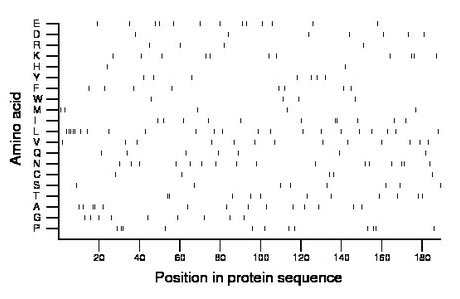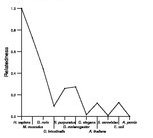
| Name: APOD | Sequence: fasta or formatted (189aa) | NCBI GI: 4502163 | |
|
Description: apolipoprotein D precursor
|
Referenced in: Lipoproteins
| ||
|
Composition:

Amino acid Percentage Count Longest homopolymer A alanine 7.4 14 2 C cysteine 2.6 5 1 D aspartate 3.7 7 1 E glutamate 6.9 13 1 F phenylalanine 4.2 8 1 G glycine 4.8 9 1 H histidine 1.1 2 1 I isoleucine 5.8 11 2 K lysine 5.8 11 2 L leucine 11.6 22 5 M methionine 2.6 5 1 N asparagine 8.5 16 2 P proline 6.3 12 2 Q glutamine 3.7 7 1 R arginine 2.1 4 1 S serine 4.2 8 1 T threonine 5.8 11 2 V valine 6.9 13 1 W tryptophan 2.1 4 1 Y tyrosine 3.7 7 1 |
Comparative genomics:
Search single species RefSeq proteins at NCBI
Search summary 
Figure data | ||
Related human proteins:Protein Relative score Description Self-match 1.000 apolipoprotein D precursor RBP4 0.082 retinol-binding protein 4, plasma precursor PTGDS 0.033 prostaglandin H2 D-isomerase PRTG 0.025 protogenin AMBP 0.025 alpha-1-microglobulin/bikunin preproprotein LOC100129193 0.019 PREDICTED: similar to hCG1795014 LOC100129193 0.019 PREDICTED: similar to hCG1795014 LOC100129193 0.019 PREDICTED: similar to hCG1795014 GOLGB1 0.014 golgi autoantigen, golgin subfamily b, macrogolgin ... CCT2 0.014 chaperonin containing TCP1, subunit 2 PCDHB14 0.014 protocadherin beta 14 precursor LCN2 0.014 lipocalin 2 LCN12 0.011 lipocalcin 12 PIK3C3 0.011 catalytic phosphatidylinositol 3-kinase 3 GPR112 0.011 G-protein coupled receptor 112 SLC9A4 0.008 solute carrier family 9 (sodium/hydrogen exchanger)... LCN9 0.008 lipocalin 9 SLC22A5 0.008 solute carrier family 22 member 5 FCGR3A 0.008 Fc fragment of IgG, low affinity IIIa, receptor (CD... FCGR3A 0.008 Fc fragment of IgG, low affinity IIIa, receptor (CD... FCGR3A 0.008 Fc fragment of IgG, low affinity IIIa, receptor (CD... FCGR3A 0.008 Fc fragment of IgG, low affinity IIIa, receptor (CD... FCGR3B 0.008 low affinity immunoglobulin gamma Fc region recepto... FCGR3A 0.008 Fc fragment of IgG, low affinity IIIa, receptor (CD1... CPS1 0.005 carbamoyl-phosphate synthetase 1 isoform a precurso... CPS1 0.005 carbamoyl-phosphate synthetase 1 isoform b precursor... SLC22A4 0.005 solute carrier family 22 member 4Human BLASTP results (used to prepare the table) | |||
Gene descriptions are from NCBI RefSeq. Search results were obtained with NCBI BLAST and RefSeq entries. When identical proteins are present, the self-match may not be listed first in BLASTP output. In such cases, the table above has been reordered to place it first.
See About the Figures for the scoring system used in the figure above right. The same scoring system was used in the table of BLASTP results.
Guide to the Human Genome
Copyright © 2010 by Stewart Scherer. All rights reserved.
